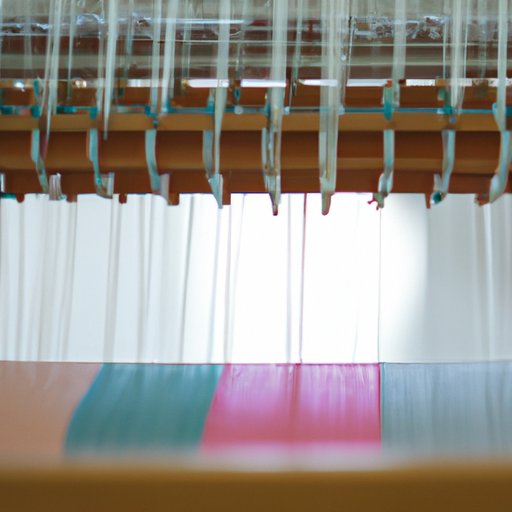Introduction
A loom is an instrument used for weaving fabric and other materials. It consists of two sets of parallel threads (known as warp and weft) stretched between two or more rollers. By interlacing these threads with each other, a fabric can be created. The art of weaving has been around for centuries and is still practiced today, with modern looms being powered by electricity.
In this article, we’ll explore the history of the loom and provide a step-by-step guide to how it works. We’ll also discuss the science behind the mechanics of a loom, as well as its role in modern loom design.
Step-by-Step Guide to How a Loom Works
Before we get into the mechanics of a loom, let’s take a look at the different parts that make up a loom. A traditional loom typically includes the following components:
- The frame: This is the foundation of the loom which holds all the other components together.
- The reed: This is a comb-like device used to separate the warp threads.
- The heddles: These are loops of cord used to raise and lower the warp threads.
- The shuttle: This is a tool used to pass the weft yarn through the warp threads.
- The treadles: These are foot-operated levers used to control the heddles.
Now that you know the parts of a loom, let’s look at how it operates. To begin the weaving process, the warp threads are wound around the rollers of the loom and secured in place. The heddles are then attached to the warp threads and the reed is placed in front of them. The weft thread is then passed through the warp threads using the shuttle, and each time the shuttle passes through, the treadles are used to raise and lower the heddles.
The heddles move the warp threads up and down, creating an opening for the weft thread to pass through. As the shuttle moves back and forth, the weft thread is interlaced with the warp threads, creating a fabric. The tension and pressure of the warp and weft threads are what gives the fabric its strength and shape.

The Science Behind How a Loom Operates
Now that you understand the basics of how a loom works, let’s look at the science behind the mechanics of a loom. To begin with, the warp threads need to be under enough tension so that the fabric produced is strong and durable. This tension is achieved by winding the warp threads around the rollers of the loom and securing them in place.
The pressure created by the heddles and the reed is also important in the weaving process. The heddles raise and lower the warp threads to create an opening for the weft thread to pass through, while the reed pushes the warp threads together to ensure the fabric is tight and even. The combination of tension and pressure creates the fabric that is produced.

A Visual Guide to Understanding the Mechanics of a Loom
To better understand the mechanics of a loom, let’s take a look at some diagrams and photographs. The following diagrams show the parts of a loom and how they work together:

The following photographs show the weaving process in action:

The Role of Technology in Modern Loom Design
Modern looms have come a long way since their ancient origins. Advances in technology have allowed for the creation of faster, more efficient looms that are easier to use. Some modern looms are powered by electricity and use computerized controls, allowing for greater accuracy and precision when weaving fabric.
Modern looms also allow for the use of multiple colors and patterns, making it easier to create complex designs. Many modern looms also have the ability to produce larger pieces of fabric than traditional looms, making them ideal for commercial production.
Conclusion
Understanding the mechanics of a loom is essential to mastering the art of weaving. From its ancient origins to its modern advances, the loom has evolved over time to become an integral part of the textile industry. As technology continues to advance, so too will the capabilities of the loom.
We hope this article has provided you with a better understanding of how a loom works. If you’re interested in learning more about the art of weaving, we encourage you to explore the many resources available online. With a little practice, you too can master the ancient art of weaving.
(Note: Is this article not meeting your expectations? Do you have knowledge or insights to share? Unlock new opportunities and expand your reach by joining our authors team. Click Registration to join us and share your expertise with our readers.)
